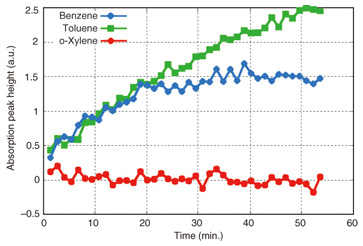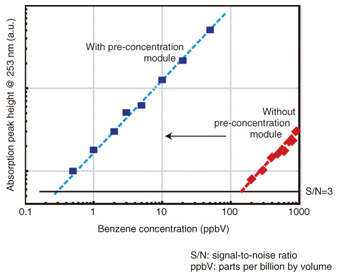 |
|||||||||||||
|
|
|||||||||||||
|
Feature Articles: Imaging and Sensing Technologies for Safety and Security Vol. 10, No. 2, pp. 38–44, Feb. 2012. https://doi.org/10.53829/ntr201202fa7 Portable Sensor for Determining Benzene Concentration from Airborne/liquid Samples with High AccuracyAbstractOur previously developed portable monitoring system for detecting airborne benzene down to the level of one part per billion (1 ppb) has been extended to a portable sensor for liquid samples through the development of modules for extraction from the liquid phase to the vapor phase based on two protocols: bubbling and pervaporation. This portable sensor has demonstrated a high selectivity to benzene or a detection limit below the one-part-per-billion-by-volume (1-ppbV) level depending on the extraction protocol.
1. IntroductionBenzene, toluene, and xylenes, sometimes referred to as BTX, have similar chemical compositions but exhibit specific properties that have led to their extensive usage in various industries (chemical industries and petroleum refineries) and in commonly used products (e.g., gasoline). However, all three compounds, but especially benzene, represent threats to human health even at trace-level concentrations. On the basis of scientific studies, developed countries have set regulatory levels that should not be exceeded in gas and liquid samples in order to prevent any impact on the human population or environmental ecosystems. Regulatory levels in Japan, the USA, and Europe are given in Table 1. Because of its large carcinogenic effect, benzene has the lowest regulatory levels, in the low-parts-per-billion (ppb, 10-9) range. Standard protocols for detecting BTX compounds have been developed, mostly on the basis of the gas chromatography and mass spectrometry (GC/MS) technique. This setup provides high reliability and sensitivity; however, it cannot be operated in the field, requires a highly skilled operator, and is costly and bulky.
Between the two main potential exposure media, liquid and gas, airborne BTX is considered to be the major threat because car exhaust has been identified as the main source of emission. This is particularly relevant in densely populated areas with huge numbers of cars on the roads. For simultaneous detection of BTX compounds on-site with a portable sensor, absorption spectroscopy in the ultraviolet (UV) optical wavelength range represents a promising alternative. In the UV wavelength range, almost all of the molecules absorb light at various wavelengths depending on the structure of their outer electron clouds. For simultaneous detection of multiple compounds, the wavelength range can be tuned to where compounds of interest exhibit strong and characteristic absorption peaks. For example, benzene, toluene, and o-xylene exhibit very distinct and well-resolved absorption signatures in the 230–290-nm range (Fig. 1) despite their similar chemical compositions. When operating in this wavelength range, this technique therefore enables simultaneous detection of the three compounds. However, the sensitivity is usually limited by the length of the light path through the sample, with the typical detection limit being in the parts-per-million (ppm, 10-6) range. To reach sensitivity in the parts-per-trillion (ppt, 10-12) range and satisfy the requirements, one usually uses a pre-concentration cell before the detection cell. The sample gas is enriched by accumulating molecules from the carrier gas over a period of time (concentration time) and releasing them instantaneously. The release of a large number of molecules within a small volume of gas usually leads to a concentration increase by a factor of 1000 to 10,000, which opens the way to gas detection at the ppt-level at the cost of a longer response time. A few years ago, we developed a portable airborne-BTX sensor [1] by combining UV spectroscopy measurements and a pre-concentration stage; it has sensitivity in the low-ppb range that satisfies the requirements [2].
However, BTX compounds diluted in liquid samples also represent a threat and there are numerous potential sources, such as industrial spillage contaminating river basins and leaking underground storage tanks at aging gasoline stations contaminating the underground drinking water network. Despite the low solubility of BTX compounds in water, which limits their concentrations to low levels, the values given in Table 1 clearly show that such contamination remains a serious issue. Standard protocols for monitoring water quality have been developed using the same aforementioned techniques, so they exhibit the same limitations. To further extend the use of our portable airborne BTX sensor to liquid samples, we have developed modules that can be attached to the airborne system to provide an adequate interface with liquid samples. From theoretical considerations, UV spectroscopy can characterize liquid samples. However, because the molecules of interest interact with the solvent matrix, the absorption peaks are broader and smaller, which makes sensitive and selective measurements much more challenging. This protocol thus operates much more efficiently with vapor-phase samples than liquid ones. To extend the use of our portable, high-sensitivity BTX sensor, we have developed two different extraction systems with specific properties (there is a tradeoff between sensitivity and selectivity) and a passive drying system that allows efficient use of the same pre-concentration stage as in the airborne system (Fig. 2).
2. Bubbling-based extraction moduleAs mentioned in the previous section, benzene, toluene, and o-xylene exhibit low affinity with water, so they are almost certain to evaporate as soon as their molecules are in close proximity to any air-liquid interface. The bubbling extraction technique takes advantage of this characteristic by increasing the air-liquid surface area to further enhance the evaporation of BTX molecules. The concept has been extensively described elsewhere [3], but can be summarized as follows. Air as a carrier gas is pushed deep inside the sample liquid contained in a closed container. Air bubbles are then created deep inside the solution. As the bubbles rise to the surface, benzene molecules evaporate at the air bubble surface and accumulate within the bubble gas volume. When the bubbles reach the surface, they release their contents into the air in the overhead space, which is gradually transferred to the detection cell. With a large number of small bubbles, we can drastically increase the air-liquid surface ratio and extract the benzene from the entire volume of the sample liquid without any limitation from diffusion to the top surface. Experiments were performed with sample solutions prepared at known concentrations by diluting an adequate amount of pure solutions. Sample solutions were prepared in deionized water at concentration levels of 0.45, 3, and 3 ppmV (ppm by volume) for benzene, toluene, and o-xylene, respectively, where the benzene-to-toluene concentration ratio was fixed to match the levels expected from gasoline spillage. Experimental results obtained with the bubbling extraction module combined with the detection cell are shown in Fig. 3. The data show absorption peak heights at 253, 267, and 272 nm versus time for benzene, toluene, and o-xylene, respectively, with the time origin of 0 corresponding to when we started the carrier gas flow. The overall shapes of the curves in Fig. 3 are similar for the three BTX compounds, with maximum response reached after only a few minutes. This is consistent with an almost instantaneous extraction of BTX molecules, where the slow decrease in the response with elapsed time comes from the delay effect of the overhead volume. The extraction process is easy and fast, and its efficiency provides highly sensitive measurement of aqueous BTX.
However, this method has one issue concerning the selectivity to benzene. Many compounds exhibit low solubility in water and can thus be extracted efficiently to the gas phase by the bubbling protocol. Toluene is an ingredient of ordinary gasoline at a concentration level several times higher than that of benzene. Since toluene and o-xylene have absorption spectra that overlap that of benzene in the 230–290-nm range, their presence, as well as the presence of the potentially many other confounding molecules in real samples, may strongly interfere with benzene measurement, which requires better accuracy. 3. Pervaporation-based extraction moduleAn alternative extraction protocol based on a pervaporation technique [4] that provides better selectivity to benzene has been developed. Pervaporation occurs when a membrane separates the liquid phase feed and the vapor gas permeate and acts as a selective barrier. It combines two different basics processes: (1) from the liquid interface, permeation of the compound of interest through the membrane and (2) its evaporation into the vapor phase at the gas interface. Components are then separated on the basis of the difference in their transport rates through the membrane. Stronger affinity between the component and the membrane material yields faster extraction. As a result, hydrophobic membranes are commonly used to remove traces of organic compounds from aqueous solutions. A typical pervaporation setup is shown in the left bottom of Fig. 2. A tube connects the gas inlet to the outlet and acts as a selective barrier between the liquid and gas phases. While flowing inside the tube, the carrier gas gathers the benzene molecules that have migrated through the tube wall and transports them towards the detection stage. Here, silicone rubber tubes, available on the market in various sizes at low cost, were used as pervaporation membranes. Experiments with calibrated BTX solutions were performed and typical results for BTX concentrations of 0.45 ppmV of benzene, 3 ppmV of toluene, and 3 ppmV of o-xylene are shown in Fig. 4. This time the extraction profiles strongly differed depending on the compound: benzene was extracted at a fast pace with a plateau reached after 30 min, toluene was gradually released from the silicone rubber at a slow and constant pace, and o-xylene was completely blocked by the membrane. As a consequence, within the first 15 min, the responses to benzene and toluene were about the same order of magnitude despite the huge disparities in their initial concentration levels. However, the plateau reached by the sensor response to benzene occurred at a level about three times lower than the maximum reported in Fig. 3, indicating a consequent loss of sensitivity.
4. Passive drying system for pre-concentration moduleAs a standard protocol in the gas-trace detection field, the pre-concentration technique has previously been implemented in our airborne-BTX portable sensor. However, after extraction from the liquid phase, the carrier gas coming out of the extraction module exhibited a relative humidity (RH) close to the saturation level, which strongly disturbed the efficiency of the pre-concentration cell through capillary condensation. To solve this problem, we added a passive drying system before the pre-concentration cell to selectively extract water molecules from the carrier gas. The passive drying system consists of a tube made of Nafion material [5]. When the carrier gas flows through this tube, the BTX molecules are retained inside the tube, while the water molecules as well as alcohols and a few other compounds can easily migrate through the Nafion membrane. This phenomenon, which is also called permeation, is equivalent to the pervaporation described earlier, but without the phase transition. As mentioned earlier, the extraction provides a carrier gas (air) with artificially high RH levels close to 100%, while the outer surface of the Nafion tube is exposed to ambient air at a RH of about 40–50%. To counterbalance the RH difference at the two sides of the Nafion membrane, the water molecules migrate through the membrane, from the inner space to the outer space. Because this phenomenon is fast and a small volume of carrier gas cannot change the RH value of the atmospheric gas surrounding the Nafion tube, this method enables one to get rid of excess water molecules, bringing the RH back to the atmospheric level, with a tube that is only a few centimeters long. The typical gain in sensitivity when the pre-concentration stage is used in combination with bubbling extraction is shown in Fig. 5. Despite a short concentration time of 5 min, the overall response is shifted towards the low concentration levels by more than two orders of magnitude, leading to a detection limit in the pptV range, which far exceeds the requirements. The same effect has been reported with the tube-extraction system, but improvements are limited to low-ppbV levels. However, a better understanding of how the pre-concentration works would make possible further improvements in sensitivity. As mentioned above, the pre-concentration cell specifically accumulates the molecules of interest from the carrier gas over the so-called concentration time and then instantaneously releases them in a small volume of carrier gas for detection. The process can therefore be viewed as integration over the first few minutes of the chromatographic extraction response, as shown in Figs. 3 and 4 for bubbling and pervaporation extractions, respectively. In both cases, increasing the concentration time will improve the sensitivity at the cost of sensor response time but also impact the response selectivity to benzene. Therefore, from Figs. 3 and 4, we can expect two different behaviors: (1) with bubbling extraction, increasing the concentration time will slightly improve the sensitivity, and the selectivity to benzene will remain unchanged and (2) with pervaporation extraction, increasing the concentration time will drastically improve the sensitivity, but the selectivity to benzene will slightly decrease over the first 20 min and then decrease more rapidly for longer concentration times. Therefore, concentration time and choice of the extraction module are two factors that can be selected according to the application requirements in terms of sensor response, sensitivity, and selectivity to benzene.
5. Concluding remarksWe have developed a portable, high-sensitivity aqueous BTX sensor by adding two modules to the airborne-detection system: a system for extraction from the liquid phase to the vapor phase, followed by a passive drying system. Two extraction systems for different applications have been implemented and successfully tested. When high sensitivity is a priority, bubbling extraction should be chosen: the sensor response is relatively fast, and sensitivity in the pptV range can be tuned by means of the concentration time. However, when selectivity to benzene is the key feature, and other compounds such as toluene and o-xylene are also present at several times higher concentration levels, then the tube extraction system should be preferred. In future, field tests should be conducted to further validate the approach and demonstrate the ability of our sensor to perform realtime, on-site measurement at levels satisfying national regulations. References
|
|||||||||||||
















